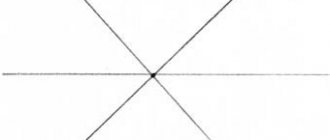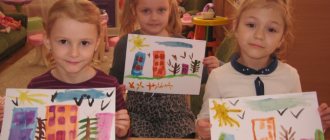Summary of OD in the middle group “Fedoreno Gore”, household work
Joint activity of teachers and children “Fedoreno Gore”, household work in the middle group (4-5 years old)
Author: Gribanova Anna Leonidovna Co-author: Sedelnikova Anna Evgenievna Position and place of work: teachers, MBDOU No. 109 “Kindergarten of a combined type”, Kemerovo. Description of the material: We bring to your attention a summary of the joint activities of the teacher and children in labor education. The material includes the following educational areas: “Cognitive development”, “Social-communicative”, “Speech development”. The notes may be useful for teachers working in the middle group. Goal: to expand children’s understanding of household work. Objectives: 1. Continue teaching how to care for dishes and instill self-care skills. 2. Fix the names of the dishes, types of dishes, material for production. 3. Develop the ability to compare objects, find commonalities, and see the geometric figure at the heart of an object. 4. Improve careful handling of dishes. 5. Cultivate a caring attitude towards dishes. 6. Develop the ability to work with both hands at the same time. 7. Promote team unity, relieve tension, correct shyness. 8. Develop the ability to enter into the image of an object, to show a non-living object with sounds, gestures, and facial expressions. Preliminary work: studying the topics: “Utensils”, “Profession - cook, teacher, junior teacher”, “Household duties”, reading the works of K.I. Chukovsky.
Equipment: a ball for the game, four sheets of geometric figures for the game “What’s What” and pictures of dishes, basins, sponges, aprons, dishes, towels, oilcloths for washing dishes, a cook doll, a teacher, a junior teacher. Progress of educational activities:
The teacher reads excerpts from fairy tales by K.I. Chukovsky, and the children guess which fairy tale the excerpt is from.
Educator: 1. Hey, you animals, come out, defeat the Crocodile, so that the greedy Crocodile will turn the Sun into the sky! Did you find out what work these words are from? Children: “Stolen Sun” 2. He is sitting under a tree. Come to him for treatment. Both the cow and the she-wolf? 3. The bears were riding a bicycle. And behind them the cat is backwards. Now let's blow really hard on the sea out of the confusion? Breathing exercises
Educator: you will listen to the next excerpt in the recording. The teacher plays a recording from the fairy tale “Fedoreno Grief”
: The sieve gallops through the fields, and the trough through the meadows.
The broom followed the shovel along the street. Axes, axes, just pouring down from the mountain, The goat got scared, widened her eyes: “What is it? Why? I won’t understand anything.” And I won't understand anything! Who was running away from whom? Children: Dishes from Fedora. Educator : Of course, you recognized this work? Children: yes, this is the fairy tale “Fedoreno Grief” Educator : which was written... Children: Korney Ivanovich Chukovsky. Next is a conversation about the dishes, about Fedora’s attitude towards them. Educator: 1. Guys, why did all the dishes run away from Fedora? 2. Why wash the dishes? You can buy a lot of pots and that’s it, why cook, eat, and then wash? 3. How did Fedora feel about her dishes? She did everything wrong, the dishes need to be loved and looked after. 4. What kind of dishes are there? (kitchen and dining room) We learn what the dishes are made of during the game. I will name the object, and you will name what it is made of (glass, plate, etc.) Guys, who in our kindergarten uses dishes? (cooks, assistant cook, teachers, children, junior teacher, dolls with toy dishes) The teacher helps the children answer this question with the help of dolls with the words “look who came to visit us?” Then they figure out why each of them needs dishes.
Educator: Now we’ll play.
I have a poster with geometric shapes, and you have cards, you need to choose each card its place. The game “What's what?” is played, after the game Fedora comes in and cries.
Educator: And here is Fedora Egorovna, hello dear, come in. Why are you crying now? Fedora: all the dishes ran away from me. Educator : Guys, what should you do with your dishes so that they don’t run away from you? Children: wash and care for it. Fedora: But of course, I don’t know how. Educator: What should I do with you? Well, first of all, I need to return the dishes. Do you even remember what you had? Fedora : Yes, I have a whole list here, you just need to guess what I have there and show me the answer. - Soup, salad, mashed potatoes, cutlets Always served in... (Plate) - The teapot's friend Has two ears, Cooks porridge, soup for Yulia. And their name is... (Pan) - There will be delicious food With a golden crust, If you use... That's right,... (Frying pan) - They take them out on New Year's Eve, They pour drinks into them for the guests, And, famous for their vocals, They ring when the clock strikes... ( Glasses) - Tell me what to call her: Her teeth are all full of holes, But she grinds beets, radishes, horseradish, carrots deftly. (Grate) - A boat is floating on my plate. I put the boat of food into my mouth. (Spoon) - And for tea and curdled milk, substitute, my friend... (Cup) - On the stove is the boss of the pots. Fat, long-nosed... (Kettle)
Educator: So we guessed and showed all the answers to the riddle. Where can I find your dishes? The teacher draws attention to the Cook doll, who saw where the dishes were hidden. And according to the prompt, counting the steps, he looks for dishes together with the children.
Fedora, together with the children, prepares the work area, distributes sponges, towels, places basins and discusses who will do what (wash, rinse, wipe, take to dry).
The children and the teacher sort the dishes into two groups, kitchen and dining, and begin washing, showing them to Fedora.
After the activity, the teacher praises the children, and together they clean their workplace.
We recommend watching:
Summary of a lesson in the middle group on the works of Marshak Notes of the GCD in the middle group “Help the Cockerel” Summary of the GCD in the middle group on the topic: “Who lives in the little house?” Summary of a design lesson in the middle group "Tumbler"
Similar articles:
Math lesson “Rectangle” in the middle group of kindergarten
Self-care for middle group children
Involving children in helping their peers is successful only if the former know in advance in what form this help can be provided and master these skills. If a child, for example, does not know how to fasten his own shoe, he will not be able to do it for another. Thus, the key to successfully connecting a child to help another is self-service. A child whose actions have been consolidated and whose skills have been developed, with great desire and interest, agrees to come to the aid of another. At the same time, practice shows that children, even having the skills of dressing and undressing, sometimes cannot apply the learned method of action in relation to their peers. Children begin to get lost, feel insecure, and turn to the teacher for help. This is explained by the fact that the guys were not taught how to transfer their skills to other conditions and situations. Therefore, the teacher’s task at first, when involving children in providing assistance, is to remind (and perhaps show and explain) what needs to be done and how. This instills in them confidence in their abilities and convinces them of their skills. Around the second half of the year, the teacher increasingly limits it to general reminders: “Do everything the way you do it for yourself, so that it is neat, correct, beautiful.” Systematic work on involving children in helping each other has a positive impact on the formation of the ability to come to the rescue without the constantly repeating demands of the teacher, independently. By the end of the fifth year of life, children not only strive to fulfill the adult’s task of helping someone, but also try to “teach” the person under their care how and what actions need to be performed. The form of assistance is becoming more advanced: in addition to direct practical actions, elements of training are increasingly appearing. When strengthening self-service skills in children, the teacher increasingly turns to their consciousness. He points out to children the permanent responsibilities in this type of work, explains why they need to be performed, and shows their importance to others. Sometimes in children by the age of 5 one can observe a decrease in interest in self-care work. This is caused by the simplicity and monotony of actions, frequent repetition of activities (dressing, putting away toys, eating, etc.), as well as the child’s insufficiently developed skills of independence, neatness and cleanliness at the previous stage. Therefore, it is necessary to interest them in the diversity of this work and create a certain emotional atmosphere. Thus, consolidating self-service skills, turning them into habits, and at the same time a condition for the formation of independence in everyday activities is maintaining interest in it. This is facilitated by the emotional experiences that the child experiences when undressing and dressing. That is why, at this age level, encouragement and objective assessment of his activities are so necessary. The emergence of a positive emotional state in self-service activities is also facilitated by the fact that the teacher brings to the consciousness of children what is good in their behavior, emphasizing the importance of independent activity for others and for the group of children as a whole. The teacher says: “Look how quickly Vanya and Sasha got dressed today. Sveta and Sonya helped them. Now let’s all play together.” Analysis of the results of work, their objective assessment becomes an effective method of raising children if the teacher strives to strengthen their desire to perform their duties better, faster, and on time. The adult gradually teaches the children to evaluate their own achievements in self-service and correct shortcomings on their own initiative. The whole atmosphere of life in a peer group helps to develop self-esteem in children of the average group. If one of the children has an incorrect attitude towards his duties (did not make the bed well, did not get dressed for a long time, and delayed the children for a music lesson), the teacher, together with his comrades, condemns him. As before, children in the middle group imitate their elders in performing self-care work, but they do it more consciously. The teacher becomes an authority for the children. They exactly repeat his actions, imitate even in small things. It is important that children feel in the tone of adults the obligation to fulfill their demands. At this age, you can already demand much more from children than from little ones.
MAGAZINE Preschooler.RF
“Labor education of children in the middle group of kindergarten”Target:
Formation of a positive attitude towards work in children 4-5 years of age.
Tasks:
- Cultivate a desire to work.
- Learn to carry out individual and collective assignments, develop the ability to negotiate with the help of a teacher about the distribution of work, and take care of the timely completion of a joint task.
- To instill in children independence, accuracy, mutual assistance, caring for each other and responsibility for a common cause.
- Explain to children the importance of their work.
- Encourage initiative in helping friends and adults.
- Learn to finish what you start.
Types of work of preschool children:
- Self-service.
- Household work.
- Labor in nature.
- Manual labor.
Forms of labor organization:
- Errands.
- Duty roster.
- Collective work (common, joint).
Labor education is an important means of comprehensive development of the personality of a preschooler. The main goal of work is its educational influence on the child’s personality. Work also has a significant impact on the mental development of a child. It requires intelligence, initiative, concentration, and trains memory. In the process of work, adults give children useful knowledge about objects, materials and tools, their purpose and use.
Children in the middle group of kindergarten are characterized by elementary household work - self-service, associated mainly with satisfying their personal needs. Children must master such actions and operations of household activities as: setting the table for lunch, breakfast or afternoon tea, preparing materials for classes, maintaining order in the room and area.
In the middle group, in addition to consolidating previously learned skills, work is being done to develop more complex self-care skills. The children are given the task of providing mutual assistance when getting dressed: tying a scarf, teaching how to tie shoes, helping the baby get dressed, etc.
In the middle group, the content of household labor becomes more complicated mainly due to an increase in the number of processes of this labor. So, at the beginning, under the supervision of a teacher, and by the end of the year, children independently maintain order in the group and in the area, take part in cleaning (wipe shelves, wash toys, etc.). In this age group, children master the integral processes of household labor (washing doll clothes, washing toys, setting the table). This requires children to know specific techniques and operations, and to be able to use them in the right sequence.
You can cultivate in children the ability and desire to work through the organization of work activities:
- Orders
- Joint activities of children with the teacher.
- Responsible for cafeteria and classes.
Assignments are the simplest form of organizing the work activities of preschool children. Errands are widely used in all age groups of kindergarten
In the practice of educational work with children, individual assignments are especially common, less often collective ones, to small subgroups of 2-3 people. Since it is much easier to teach one or two children than a whole group, and monitoring the actions of everyone is more convenient.
Duty duty is a more complex form of organizing children’s work. They require more independence from the child. The attendants learn to carry out the assigned task completely; this requires children to know the sequence of necessary actions.
The volume of tasks for labor education increases from the middle group, reaching a maximum in the senior group. It is in the middle group that children actively master various work skills and techniques of working in nature, household and self-service work.
In the process of labor, children acquire the necessary skills, including the skills of caring for plants and animals (labor in nature), master the simplest operations with objects, learn about materials and their properties (manual labor). Children develop an interest in work and a desire to work (household work, self-service).
| Next > |




